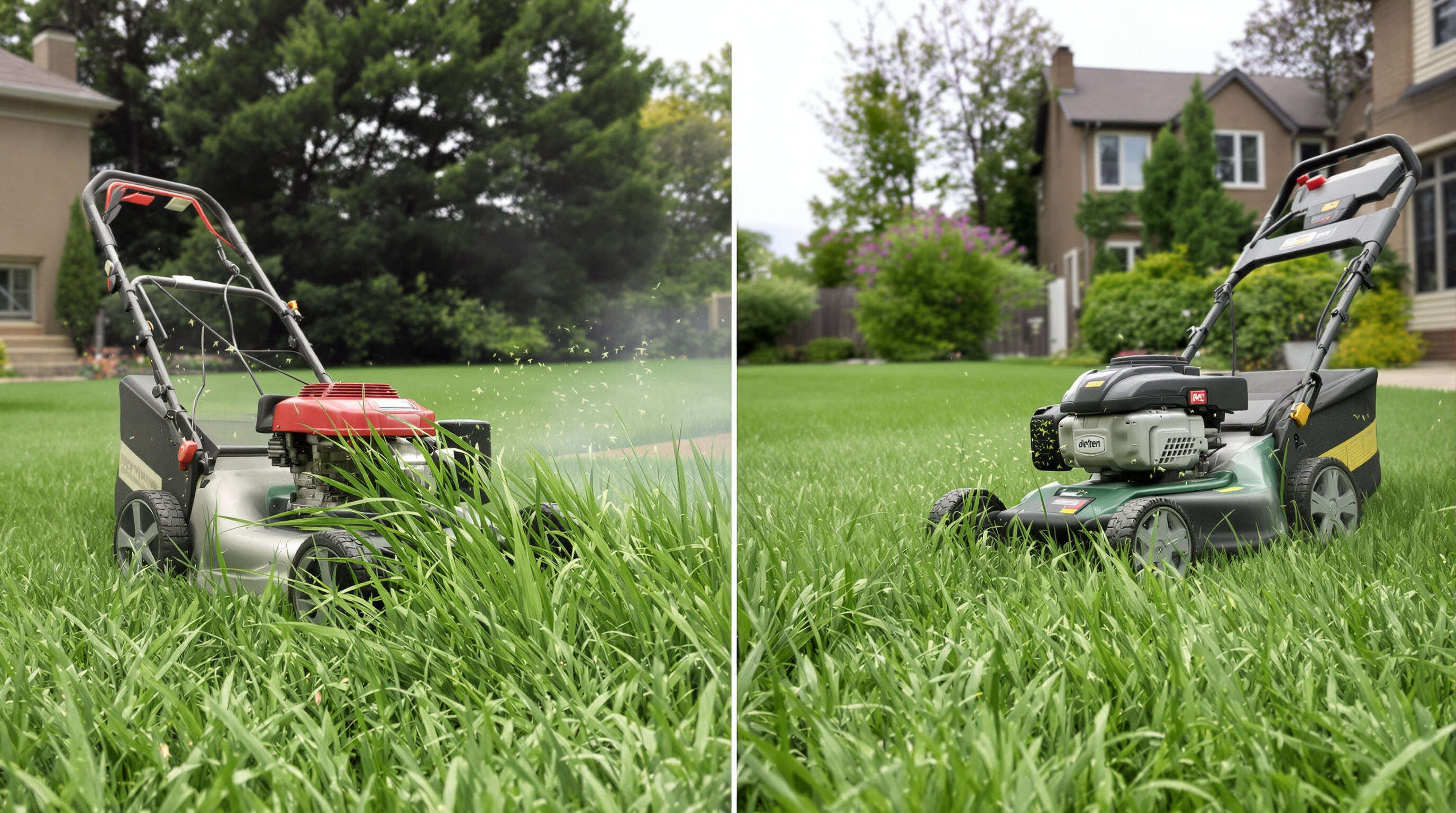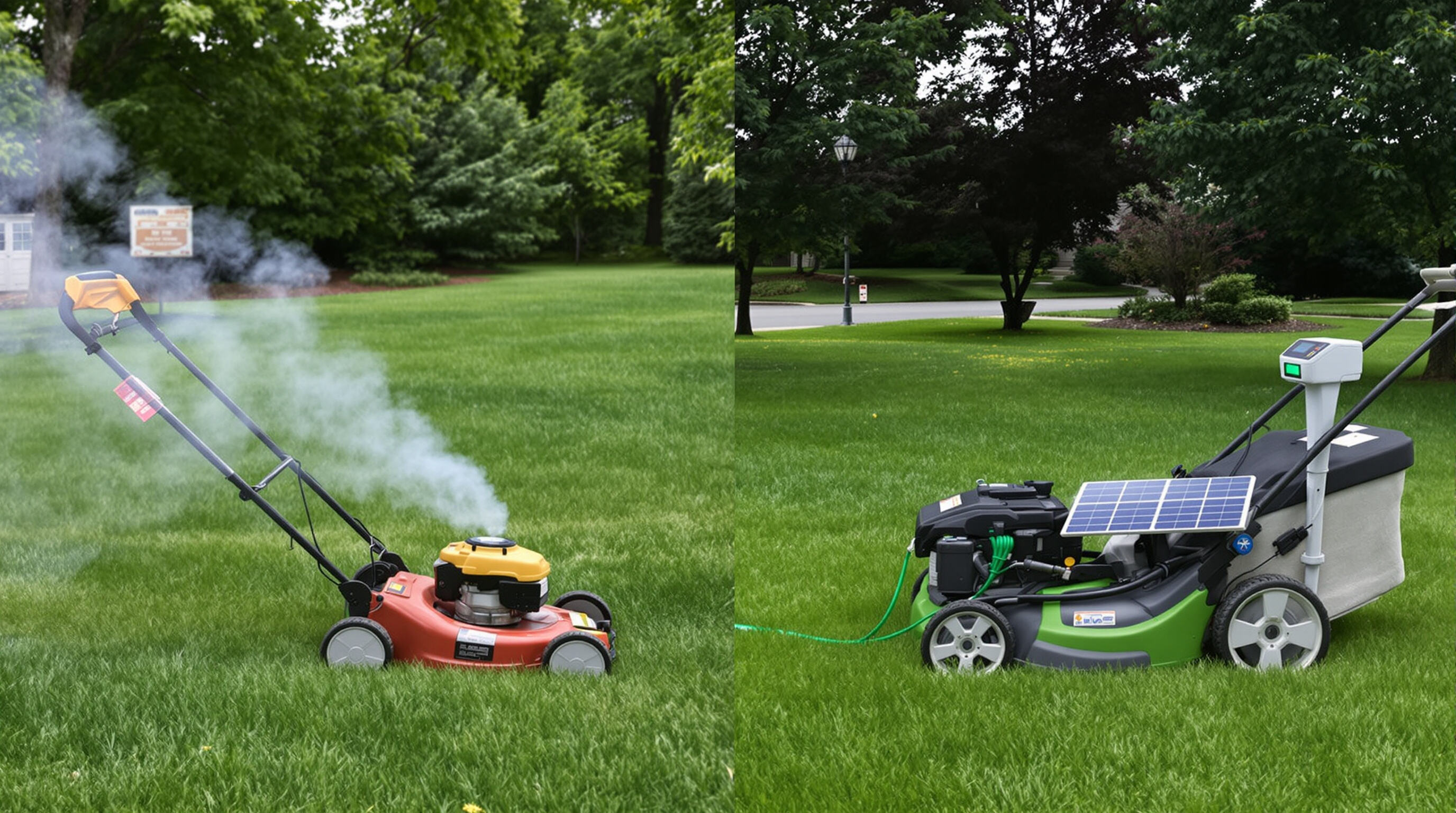Performance: Gasoline Lawn Mower Power vs. Electric Efficiency

Power Output and Cutting Efficiency of Gasoline Lawn Mower
Gas powered lawn mowers usually put out around 4 to 7 horsepower, though some commercial grade units can go above 10 HP when dealing with tough jobs. The extra power means the blades keep spinning steadily even through thick patches of grass, so landscapers don't have to make as many passes over the same area. Electric mowers on batteries generally max out at about 2 to 4 HP in actual use, which means they often need an extra run or two to get the job done right in really thick grass according to last year's landscaping industry report from 2024.
Torque and Speed: Gas vs. Electric Lawn Mowers
Gas engines generate instant peak torque of 6–9 lb-ft, accelerating blades to 3,000–3,600 RPM rapidly and maintaining performance under load. Electric motors experience a 0.5–1.5 second delay in torque delivery but offer smoother power application. Field tests show gas mowers complete tasks 18% faster on slopes ≥15°, thanks to their mechanical torque advantage.
Case Study: Mowing Performance in Mixed Terrain (0.5–1 Acre)
A 2023 study of 40 residential properties found gas mowers completed 0.75-acre lots with mixed elevation 22% faster than premium battery models (82 vs. 104 minutes). Over half of electric mower users required mid-task battery swaps, adding 8–12 minutes per charge cycle.
Trend: Increasing Motor Efficiency in Battery-Powered Mowers
Modern brushless electric motors achieve 85–90% energy efficiency, far surpassing the 25–30% efficiency of gas engines. This advancement is narrowing the performance gap. Leading 2024 battery models sustain 90+ minutes of peak torque output—a 34% improvement since 2021 (Green Tech Labs 2024). Dual-battery systems now match gas mower runtime for lawns up to 0.5 acres.
Environmental Impact and Sustainability of Gasoline Lawn Mower vs. Electric Models

Emissions data: Gas-powered mowers vs. zero-emission electric models
Running a gas-powered lawnmower spews out around 6.2 kilograms of carbon dioxide for every acre cut, whereas electric versions only put out about 0.45 kg (as reported in the 2023 Power Equipment Study). That massive difference of nearly 93% happens because there's no actual burning going on with electricity. And it gets worse for traditional mowers - they pump out VOCs at levels similar to what would come from eleven cars sitting idle for an entire hour, something the Environmental Protection Agency has tracked closely in their air quality reports. On the flip side, electric models don't release anything during operation at all. Plus, if someone charges them using solar panels or wind power, these machines become genuinely sustainable options for maintaining green spaces without harming the environment.
Battery production and disposal concerns in electric mowers
Lithium-ion battery production requires 68% more initial energy than manufacturing gas engines, and mining rare earth materials raises ecological concerns. However, modern recycling programs recover 95% of battery components. A typical 5Ah lawn mower battery contains 0.8 lbs of recyclable lithium—enough to power three smartphone batteries after refurbishment.
Controversy Analysis: Are electric mowers truly greener?
Looking at their entire life cycle over ten years shows that electric lawnmowers actually make up for the carbon cost of making them within just about 18 months of regular use. Sure, these machines do require 22 percent more resources when first manufactured, but over time they save a massive amount of greenhouse gases. We're talking around 693 thousand pounds less CO2 released into the atmosphere per mower compared to those old gas powered ones. And this gets even better as batteries keep getting more efficient and our power sources become greener. The overall environmental effect from start to finish? Electric models come out looking much better than traditional options, with studies showing roughly 83 percent less harm to the planet throughout their whole lifespan.
Cost Comparison: Gasoline Lawn Mower Maintenance and Long-Term Value
Routine Maintenance Needs for Gasoline Lawn Mower (Oil Changes, Spark Plugs)
Gasoline mowers require 3–5 times more annual maintenance than electric models. Key tasks include oil changes (0.6–1.2 quarts per year), spark plug replacements every 100 hours, and seasonal air filter cleanings. A 2023 equipment study found gas mower owners spend $120–$150 annually on maintenance and servicing, compared to $20–$30 for electric mowers.
Operating Costs: Fuel Consumption of Gas-Powered Lawn Mowers vs. Charging Expenses
Gas mowers consume 0.5–1 gallon per hour, costing over $200 per season for a 0.5-acre yard at current fuel prices. Electric models use $3–$5 in electricity annually for the same workload—a 90% reduction. However, battery replacements every 3–5 years ($150–$300) partially offset these savings.
| Cost Factor | Gasoline Mower (5 Years) | Electric Mower (5 Years) |
|---|---|---|
| Initial Purchase | $350 | $450 |
| Maintenance | $600 | $150 |
| Fuel/Energy | $1,000 | $75 |
| Total | $1,950 | $1,350 |
Source: Lawn Care Business Report 2024
Total Cost of Ownership Over 5 Years by Mower Type
The table above shows electric mowers save over $600 in five years despite a higher initial price. Gas mowers are only more cost-effective for properties larger than 1.5 acres with 200+ annual runtime hours.
Resale Value and Brand Longevity Trends
Well-maintained gasoline mowers retain 40–50% of their value after five years due to widespread repair infrastructure. Electric models depreciate faster, averaging 30% residual value, largely due to buyer concerns about battery health. EPA-certified commercial gas mowers from established brands command a 15% resale premium (Machinery Today 2023).
Ease of Use: Starting, Noise, and Handling in Gas vs. Electric Mowers
User Experience: Pull-Start Struggles vs. Push-Button Electric Ignition
Starting a gas mower means dealing with that annoying pull cord every time, which takes about 30% more effort compared to electric ones according to some recent research from 2024. People who have tried both types often mention around two thirds of them struggle getting the gas engine going sometimes, even though these older models tend to work better when it's chilly outside. Electric mowers just need a simple button press to start right up without all the hassle of mixing fuel or fiddling with the choke settings. Most folks find they save roughly 15 minutes each time before actually cutting grass because there's no prep involved other than plugging it in. Turf Magazine did some testing and confirmed this observation as well.
Weight and Maneuverability Differences Affecting Operator Fatigue
Gas mowers weigh 25–40 lbs more than comparable electric models, significantly increasing operator fatigue. Studies show this weight difference leads to 52% greater fatigue during 60-minute sessions (Lawn Care Ergonomics Institute, 2023). Electric mowers’ lighter build and balanced design allow tighter turns and better navigation around landscaping obstacles.
Noise Levels During Operation: Gas vs. Electric Lawn Mowers
Gas powered lawnmowers typically produce around 85 to 95 decibels of noise, roughly similar to what someone might experience riding a motorcycle. Electric versions are much quieter though, operating between 65 and 75 dB, about the same level as people talking normally in a room. According to some research from Consumer Reports, switching to electric models cuts down on noise pollution by nearly 78 percent. That makes these machines great choices for cutting grass early in the morning when neighbors are still asleep, since they won't trigger complaints about loud noises breaking local regulations. With this 20 dB gap between gas and electric options, most people can cut their yards without needing ear protection, and communities generally find the overall noise levels much more comfortable to live with.
Yard Size and Terrain Suitability for Gasoline Lawn Mower and Electric Options
Ideal Yard Size for Gasoline Lawn Mower: Over 1 Acre Performance Advantage
For lawns bigger than an acre, gasoline mowers tend to work better overall. These machines have combustion engines that can handle tough situations like dense grass patches or bumpy ground. Most models will run nonstop for about an hour to an hour and a half before needing fuel. According to recent studies from landscape equipment experts in 2024, gas mowers finish cutting 1.5 acre yards around 22 percent quicker compared to electric ones when dealing with varied lawn conditions. That makes sense why many folks living on bigger plots of land or out in the country still prefer these traditional mowers despite all the newer battery options available now.
Battery Life of Electric Lawn Mowers and Runtime Limitations
Even high-capacity 80V electric mowers typically deliver 45–60 minutes of runtime under load. While sufficient for yards under 0.5 acres, larger lawns often require spare batteries ($150–$300 each). Runtime drops by 35% when cutting dense grass or climbing slopes, requiring careful planning for properties approaching 1 acre.
Corded vs. Battery-Powered Electric Mowers: Mobility Trade-Offs
- Corded models: Offer unlimited runtime but are limited to 100 ft from outlets, increasing tripping hazards and reducing maneuverability
- Battery-powered: Provide cord-free operation but face diminishing returns—each 2 Ah battery adds 1.5 lbs while extending runtime by only 12–18 minutes
Slope Handling and Cutting Consistency Across Power Sources
Gas mowers maintain consistent torque on inclines up to 20°, making them reliable for undulating terrain. Electric models show 17% slower blade speeds on 15° slopes in controlled tests, particularly struggling with wet grass clippings. Self-propelled features help close this gap, but combustion engines remain superior for challenging landscapes.
FAQ
What are the power output differences between gasoline and electric lawn mowers?
Gasoline mowers typically offer 4 to 7 horsepower, with commercial models going above 10 HP, whereas electric mowers provide about 2 to 4 HP. This influences their efficiency in cutting through thick grass.
How do gasoline and electric lawn mowers compare in terms of environmental impact?
Gas-powered mowers emit significantly more carbon dioxide and VOCs compared to electric mowers. Electric mowers produce zero emissions during operation, especially when charged with renewable energy sources.
What are the long-term costs associated with gasoline versus electric lawn mowers?
While gasoline mowers have lower upfront costs, they entail higher maintenance and fuel expenses. Electric mowers might cost more initially but save more over time due to lower energy expenses.
How do noise levels differ between gas and electric mowers?
Gas mowers generate around 85 to 95 decibels, comparable to motorcycle noise, while electric mowers operate at 65 to 75 dB, similar to a normal conversation, reducing noise pollution significantly.
Are electric mowers suitable for larger lawns?
Electric mowers with high-capacity batteries can manage lawns under 0.5 acres efficiently, but lawns nearing 1 acre may require additional batteries due to runtime limitations.
Table of Contents
- Performance: Gasoline Lawn Mower Power vs. Electric Efficiency
- Environmental Impact and Sustainability of Gasoline Lawn Mower vs. Electric Models
- Cost Comparison: Gasoline Lawn Mower Maintenance and Long-Term Value
- Ease of Use: Starting, Noise, and Handling in Gas vs. Electric Mowers
- Yard Size and Terrain Suitability for Gasoline Lawn Mower and Electric Options
-
FAQ
- What are the power output differences between gasoline and electric lawn mowers?
- How do gasoline and electric lawn mowers compare in terms of environmental impact?
- What are the long-term costs associated with gasoline versus electric lawn mowers?
- How do noise levels differ between gas and electric mowers?
- Are electric mowers suitable for larger lawns?

